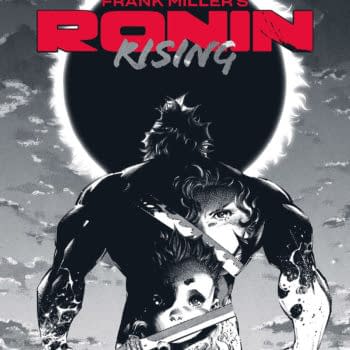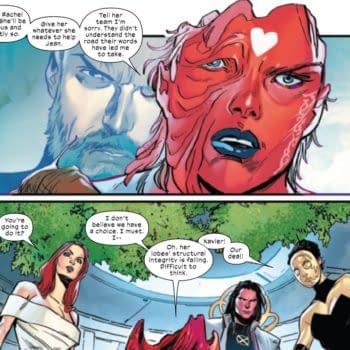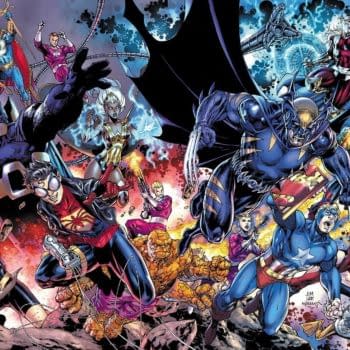Posted in: Comics | Tagged: scott snyder, sean murphy, The Wake, vertigo
Diving Deeper Into The Wake #5: An In-depth Discussion Of The Series So Far
One of our New York correspondents, Elizabeth Heyman, writes for Bleeding Cool:
The fifth issue of Vertigo's The Wake was already legendary among the book's readers a month before it was even released. Simply alluding to the particular comic anywhere within earshot of a comic shop or an online forum would always be met with the same raised eyebrows and perked interests as the issue quickly gained the unofficial title of "The one Scott Snyder kept mentioning at New York Comic Con."
It is an accurate description. Between the barrage of questions regarding Batman and Superman Unchained spoilers (which Snyder is often good at giving away at panels whether his editors want him to or not), DC's go-to author did repeatedly make sure to mention that the midway point of the ten issue series would be the most critical release yet. Although truthfully he didn't need to really say anything to make sure his readers returned as we all had been waiting throughout October and most of November to finally receive answers to the mysteries left by the four previous releases. Although, while we began seeing some results regarding that request, issue #5 also propelled the story into the future world that had only been previously alluded to in the flash forward panels. With that said, there seems to be no better time than now with this issue to discuss what the series has accomplished thus far and what the possible future may look like.
[*Spoilers for issue #5 below!]
In tradition with The Wake's style of breaking from action sequences to further the more cerebral underlying plotline, issue #5 does not begin where the cliffhanger conclusion of #4 left off. Rather, Snyder takes time to set the stage with another flashback, focusing more on creating a poetic metaphor than on providing conclusive answers to the critical questions that had still been left open from past issues. Although, you can never truly be certain with this book what is really there simply for aesthetics and what is actually foreshadowing, at least not until you reach the last pages.
However, the temporary serenity from moments like this one is a scarce commodity in this issue as there simply isn't enough time for it. All of the panels are packed with more action and plot development than we have ever seen in past books though you could hardly accuse it of feeling rushed. In actuality, the sci-fi horror piece keeps pace with typical thriller progression as we are finally reaching the tipping point when we can witness the culmination of the previously building suspense.
Just as the whole team continues to fight off their aquatic counterparts, The Wake's protagonist, Lee, is finally discovering the truth behind why this deep sea population is only emerging now and more importantly what her previous experiences has to do with them.
Yes, we are finally beginning to get a sense of the larger story Snyder has been setting up this entire time. It feels like everything has been building up to this moment as the mystery behind all these abstract allusions and unexplained origins begins to unfold in the last seconds of Part I of the series.
What I can't emphasize enough is exactly how thoughtful artist Sean Murphy's work is in regards to the story's movement. The first portion of this issue saw some of the most colorful (and thus unexpected) spreads we've seen since possibly the premier, not so coincidentally coinciding with the reveal of many of the story's biggest answers. The characters as well as the reader are literally being brought into the light with this issue, at least for a moment. But as this information may be coming too late for some, we are forced to fall back into black, becoming immersed in it completely with no relief but white text bubbles. However, as Part I comes to a close, we are relieved from the blackness just in time to be reminded that there is still a whole futuristic subplot to look forward to.
The tension of constantly being in between the utter darkness of confusion and the sudden contrasting light of realization is a continuous theme throughout the series and really demonstrates how the creative team is telling a story about the human experience through a fictional tale of evolutionary deviance and original mystery. It truly achieves the vision of an anthropological epic that Snyder originally described it to be.
Adding to the theme of true human nature, one of the most refreshing aspects of the Snyder's story telling is that we aren't offered the usual array of characters with identical, predictable reactions to the possibility of death or annihilation. We as readers don't have to suffer through either the "everyone's a badass survivalist motherf***** because it's the end of the world" shtick or the even more inspirational "everyone is paralyzed by cowardice in the face or mortality because human beings are such babies" gig. What we get to see with the characters collected in the underwater rig is a range of realistic human reaction, a range that is even noticeable within each individual alone as the conflict progresses.
Consider Lee; as strong of a leader as she may be, she's realistically multifaceted and shows moments of weakness and confusion when certain difficult discoveries come to light. Her insecurities as a mother as well as a person are the most prevalent as we get to witness her fears and past trauma surface during times when survival is uncertain.
In this way, The Wake really is an anthropological epic, as we get to view what threats truly terrify us the most and how our reactions to certain realizations reveal more about our nature than the evolutionary discoveries themselves.
As for the changing gears, what we should expect to see from here on out is how the population in two hundred years has resourcefully adjusted to the events that unfold in issue #5, and of course we should also expect to see more of the sonic dolphin that has only made quick appearances in the past. In fact the whole universe created by Snyder and Murphy should be an imaginative take on a post-apocalyptic world as Snyder did claim at NYCC that the second half of the series would transition more into a theme of wonder rather than terror. I hope that would entail exploring the resilience of mankind in a way that's both compelling and unexpected.
But even with all of Snyder and Murphy's accomplishments throughout the book itself, the biggest challenge the title has faced is having its concept easily read by mainstream audiences without ever having them leaf through the pages. The story is in a way plagued with having the strong essence of a traditional genre comic without committing to a specific, recognizable trope that can be advertised to jaded, impatient readers. Any publisher, TV producer, or film director can tell you that it is much easier to spark interest in a project when you lead with a subject that all people can recognize. Vampires, zombies, fairy tales—you can add whatever interesting twist you can think of to make it a unique and compelling story, but having your audience already understand the basic premise is a good first step to bringing them in. The Wake doesn't necessarily have that advantage. Sure, you might be able to call it a dark, sea monster thriller but using the term "monster" would almost be reductive to the anthropology of the prehistoric aquatic population Snyder so painstakingly developed. And certainly while reading, one would be able to notice the more subtle influences of classic science fiction thrillers, but the title as a whole can't truly be pinned down to any one layout without compromising some aspect of the story.
This is not a criticism or suggestion for change, as much as it is an observation. The fact of the matter is that it is that deviance from traditional presets of sci-fi writing that truly allows for the work to stand apart not only for its subject matter but for its compelling artistic value. It is for that reason that The Wake demonstrates Vertigo's continued dedication to the same risk taking editorial decisions that earned the imprint its stripes to begin with.
Back in June, I wrote an article (my first ever for Bleeding Cool) about how I believed The Wake #1 was a good enough omen to have faith in what was to come from the Shelly Bond Age of Vertigo. Hardly even a week after the publication of that piece, the DC imprint announced six new titles that would be added to the lineup, titles such as Trillium and Federal Bureau of Physics (originally released as Collider) that demonstrate that same risk taking, innovative way of storytelling. Snyder and Murphy's book not only continues the tradition of the 'story over glory' mentality, the insistence on breaking new ground and making new presets in the world of science fiction as well as comics, but it exemplifies it. The successes that follow this kind of original writing style not only speak to the timelessness of Vertigo's philosophy but the talents of an inventive creative team.
Elizabeth is a relatively recent addition to the Bleeding Cool team. You can follow her on twitter @bridgentunnel




















